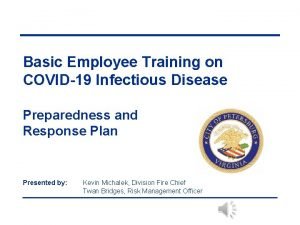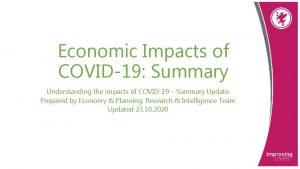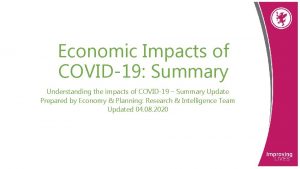Economic Impacts of COVID19 Summary Understanding the impacts


















- Slides: 18

Economic Impacts of COVID-19: Summary Understanding the impacts of COVID-19 – Summary Update Prepared by Economy & Planning: Research & Intelligence Team Updated 29. 03. 2021

Economic activity and output have fallen significantly • • • UK GDP grew by 1% in Q 4 2020 following strong growth in Q 3, with GDP remaining 7. 8% below Q 4 2019 pre-pandemic levels. Total weekly hours worked are still low but showing upward signs of recovery. Early estimates for February 2021 indicate the number of payrolled employees was 2. 4% below the rate seen in the previous year. Monthly GDP Index, January 2007 to December 2020, 2018 = 100 Sources: ONS, GDP First Quarterly Estimate (Q 4), January 2021 Labour Market Overview

Employment has dropped slightly since March 2020, with an increased claimant count and reduced vacancy postings • • • Interest in unemployment data is high, but its reliability is an issue The vacancies recovery has slowed in recent months, with Dec -Jan vacancies remaining 26. 8% lower than the year previously. From Nov-Jan 2021, the estimated employment rate was 0. 3 percentage points down on the quarter, with unemployment hitting 5%, 1. 1 percentage points higher than a year earlier. The redundancy rate from Nov-Jan reached 11 per thousand, a higher level than prior to the pandemic. Claimant count has increased significantly since the onset of the pandemic in March, reaching 2. 6 million in January. Source: Office for National Statistics – Labour Market Overview For more info on issues pertaining to unemployment data please refer to our COVID-19 Info Pack November to January 2021

Labour Market Headline Indicators in the South West – March 2021 • The SW’s employment rate stood at 76. 8% from November to January 2021, with no change being observed on the previous quarter but a drop of 3. 1 percentage points when compared to the same period a year previously. • The South West has also seen a significant drop in overall job numbers, with provisional December 2020 figures indicating a drop of 45, 000 jobs on the previous quarter and 144, 000 fewer jobs than a year earlier. • The SW’s unemployment rate stood at 4. 4% from Nov-Jan 2021, a reduction of 0. 1 percentage points on the quarter but a 1. 4 percentage points increase on the same period last year. • In addition, the South West’s economic inactivity rate stood at 19. 6% from Nov-Jan 2021, an increase of 2 percentage points on the same period a year prior. Source: Regional headline labour market indicators for the South West. All figures are seasonally adjusted.

Somerset claimant counts have risen sharply since March • • • There has been a steep rise in the claimant count across Somerset since March 2020, with 4. 9% of Somerset’s working age population claiming out-of-work benefits in February 2021. Somerset had consistently lower claimant rates than the national average before the crisis and this remains the case. Please Note: Claimant count figures do NOT provide a direct measure of unemployment and claimant conditionalities were relaxed in response to the COVID-19 crisis. Mar 20 May - July - Sep 20 20 20 Nov - Jan 20 21 Cumul ative Increa se Mendip 2. 3 5. 5 5. 6 5. 4 5. 0 +2. 7 Sedgemoor 2. 8 5. 6 5. 5 5. 3 5. 0 +2. 2 Somerset West & Taunton 2. 2 4. 8 4. 7 4. 6 4. 5 +2. 3 South Somerset 1. 9 4. 7 4. 6 4. 7 4. 5 4. 3 +2. 4 Somerset 2. 3 5. 1 5. 0 4. 9 4. 7 +2. 4 South West 2. 2 5. 4 5. 3 5. 2 5. 0 4. 8 +2. 6 United Kingdom 3. 0 6. 4 6. 3 6. 4 6. 2 +3. 2 Claimant Count as a Proportion of Residents 7, 0 6, 0 5, 0 4, 0 3, 0 2, 0 1, 0 Au Se gus t pt em 201 be 9 Oc r 2 01 to No ber 9 ve 2 m 019 b De e ce r 20 m be 19 Ja r 20 nu 19 a Fe ry 2 br 0 ua 20 ry M 202 ar ch 0 2 Ap 020 ril 20 2 M ay 0 20 2 Ju ne 0 20 Ju 20 ly Au 20 2 Se gus 0 t 2 pt em 02 be 0 Oc r 2 02 to No ber 0 ve 2 m 02 De ber 0 ce 2 m 020 be Ja r 20 nu 20 ar y 2 02 1 0, 0 Mendip Sedgemoor SWT South Somerset South West United Kingdom Source: NOMIS, Claimant Count by Sex and Age (non-seasonally adjusted)

The economic impacts of C-19 have been particularly disruptive for young people • Those in the 18 -24 age bracket have seen a decrease in the employment rate from 63. 8% in Dec 2019 -Feb 2020 to 60% in Nov-Jan 2021, an estimated drop of 248, 000 people. • In addition, the estimated number of people unemployed aged 18 -24 has increased by 83, 000 since Dec 2019 -Feb 2020 to Nov-Jan 2021, with other age groups seeing more minimal changes by comparison. The youth unemployment rate (18 -24 yr old’s) hit 13. 2% from Nov-Jan, compared to 5. 1% for the rest of the UK. • These figures are reinforced by broader research by the Resolution Foundation, which found the proportion of 18 -24 yr. old’s who weren’t students to have been three times more likely to have lost their main job since C-19 began. • Indeed, a fifth of all workers making use of the CJRS are under the age of 25. • 18 -24 year old’s have also been the most susceptible to pay swings, over a third have had their pay reduced since before the outbreak. • 18 -24 year old’s who are not full-time students are also disproportionately likely to not be able to work from home, primarily due to a large proportion of this group working in sectors such as retail and other service occupations. • Those looking for jobs fresh from University have also struggled, with the number of graduate jobs advertised falling by 60. 3% in the first half of 2020.

Furlough numbers have decreased substantially from their peak, but renewed restrictions in January have reversed this trend somewhat • • • Initially the number of employments furloughed increased quickly following the announcement of the scheme on 20 March, reaching 4. 8 million on 23 March and 6. 8 million by the end of March Following further strong growth at the start of April the number of employments furloughed increased gradually and peaked at 8. 9 million on 8 May 2020 After the early May peak, the number of employments furloughed decreased slowly before a fall of around 670, 000 employments between the end of May and the start of June The number of employments that were furloughed then continued to reduce throughout June to 6. 8 million on 30 June. latest figures show the employments furloughed increased in January to 4. 9 million employments furloughed on 31 January, coinciding with tighter restrictions on business opening that were introduced on 6 January provisional figures for February are slightly lower at 4. 7 million furloughed at 28 February, but final levels are expected to be broadly similar across January and February once all claims and amendments for February have been received

Whilst overall furlough rates have decreased, some sectors continue to be impacted worse than others, with tightening of restrictions in January 2021 having an impact • At 31 January, the sector with the highest proportion of its workforce eligible for furlough that were furloughed was the accommodation and food services sector at 61% followed by arts, entertainment and recreation at 55% • Take-up rates across all sectors remained similar when comparing figures for 31 January with provisional estimates for 28 February • At 88, 800, the accommodation and food services sector had the largest decrease when comparing the number of employments furloughed at 31 January to provisional figures for 28 February • The other service activities sector was the only sector to see an increase in the number of employments furloughed between 31 January and 28 February, with the number of employments furloughed increasing from 223, 800 to 224, 800 National Furlough Take-Up Rate by Industry (January 31 st 2021) Accommodation & food services Arts, entertainment, recreation and oth. . . Other service activities Wholesale and retail; repair of motor. . . Construction National Average Real Estate Administrative and support services Transport & storage (inc postal) Manufacturing Professional, scientific & technical Agriculture, forestry & fishing Information & communication Waste and Recycling Education Mining, quarrying & utilities Health Finance & insurance Energy Production Public administration & defence 61% 55% 41% 22% 19% 16% 15% 14% 13% 12% 10% 9% 8% 6% 4% 4% 3% 2% 1% 0% 10% 20% 30% 40% 50% 60% 70%

2. 2 million claims have been made to the third SEISS grant nationally, with the Construction Industry dominating overall claims SEISS third grant claims • Via this process, 3. 4 million selfemployed individuals were identified as potentially eligible for the Self. Employment Income Support Scheme. • By 31 January 2. 2 million (65%) of the potentially eligible population had claimed a third Self-Employment Income Support Scheme grant with the value of these claims totalling £ 6. 2 billion. • Around 91% of claimants are aged between 25 and 64 and take-up of the grant in those age groups is at or above 62%. No one single age group dominates take up of Self. Employment Income Support Scheme 3 grants. • The sector with the highest number of potentially eligible individuals and the highest proportion of claims is the construction industry. By 31 January, construction workers had made 747, 000 claims for Self-Employment Income Support Scheme 3, totalling £ 2. 6 billion. Source: HMRC, Self-Employment Income Support Scheme Statistics Proportion of total value of claims to 3 rd SEISS Grant - 31 st January 2021 Construction 42% Transportation and storage 7% Other service activities 6% Wholesale and retail trade; repair of. . . 5% Professional, scientific and technical. . . 5% Administrative and support service. . . 5% Human health and social work activities 4% Education 3% Arts, entertainment and recreation 3% Manufacturing 2% Accommodation and food service. . . 2% Information and communication 1% Financial and insurance activities 1% Agriculture, forestry and fishing 2% Real estate activities 0% Public administration and defence; . . . 0%

Usage of the CJRS and SEISS has remained high in Somerset at the start of 2021 • • • 31 st As of the of January 2021, 38, 200 employments had been furloughed in Somerset (15% take-up rate), a significant drop from the 78, 300 employments furloughed at the end of July 2020 (a take-up rate of 30%). As of the 31 st of January 2021, 66, 600 self-employment claims had been made in Somerset to receive income support. This amounted to an estimated £ 187 million in support across the three SEISS grants. Accommodation & Food made up around 26% of all employments furloughed in Somerset on the 31 st of January, followed by Wholesale & Retail (20%), with Education a distant third (7. 7%). Source: HMRC, Coronavirus Job Retention Scheme Statistics Employments Furloughed in Somerset by Industry, January 2021 9 840 Accommodation and food services Wholesale and retail; repair of motor. . . 7 470 Education 2 950 Manufacturing 2 750 Arts, entertainment and recreation 2 170 Administrative and support services 2 080 Construction 2 010 Professional and scientific and technical 1 990 Other service activities 1 940 Health and social work 1 390 Information and communication, Financ. . . 1 380 Transportation and storage 1 220 Agriculture, Mining, Energy, Water and. . . 610 Public administration and defence; socia. . . 440 0 3 000 6 000 9 000 12 000

Circa 1870 reported redundancies as of 11 th December, with many more at risk, in addition to many businesses saying they plan to make more redundancies by the end of 2020 Company Area Number of redundancies Oscar Mayer Chard (South Somerset) 860 at risk Debenhams Taunton (SWT) 257 Mulberry Chilcompton (Mendip) 200 confirmed, further 65 at risk Clarks Street (Mendip) 100 Relyon Wellington (SWT) 82 Swallowfield (KDC/One) Wellington (SWT) 40 Food Manufacturer Mendip 21 Leisure Business Mendip 25 Honeywell Yeovil (South Somerset) 77 Leonardo Yeovil (South Somerset) 150 Longleat Enterprises (Cheddar Gorge) Mendip 40 Shaul Bakeries LTD SWT (Taunton/Wellington), Sedgemoor (Bridgwater) 22 Results from our Business COVID-19 Impact Survey reveal 349 additional redundancies have been made since March across respondent businesses, with a further 429 planned this year. Please Note: • The above are tentative figures, with some unconfirmed/subject to ongoing consultation. • Some redundancies were already planned prior to the COVID-19 pandemic. • Some companies have been anonymised for confidentiality purposes. • Some businesses will self-report they intend to make redundancies in the future but may not necessarily make them if business conditions change.

Trading status, financial performance and business resilience have all been impacted significantly by the pandemic The re-imposition of lockdown restrictions in November have continued to impact businesses negatively. Headline Industry Insights: • The latest ONS Business Impact Survey from the period 8 -21 st March 2021 , reported 74% of businesses had been trading for more than the last two weeks across industries, a figure that is still below the 84% seen in mid-December 2020. • The other service industry had the lowest percentage of businesses currently trading, at 20%. The accommodation and food service activities industry was the only other industry where less than half of businesses were currently trading, at 40%. Financial Performance • The percentage of currently trading businesses experiencing a decrease in turnover has fallen from 46% in January 2021 to 42% in early March 2021. • The accommodation and food service activities industry had the highest percentage of businesses experiencing a decrease in turnover compared with normal expectations, at 69%. Business Resilience • Since November 2020, the percentage of businesses with three months' cash reserves or less has increased to approximately 31% from 27%. • More than half of businesses in the other service activities industry (which includes hairdressing and other beauty treatment activities) had three months' cash reserves or less in mid-March 2021. Workforce: • The proportion of businesses’ workforce on furlough leave increased from 11% in early December 2020 to 20% in early February 2021, significantly lower than the first national lockdown. • The proportion of businesses' workforce on furlough leave increased from 11% in early December 2020 to 19% in early March 2021.

There are significant challenges for many industries, although these impacts are highly varied Retail: • The wholesale & retail trade initially struggled markedly as a result of lockdown measures. However, Retail grew by 0. 3% in December, with output 2. 7% above February 2020 levels, Much of this growth can be attributed to the re-opening of car showrooms, with motor trades growing by 12. 3% in December. • National retail sales data for December 2020 showed an increase of 0. 3% compared to November 2020, resulting in an increase of 2. 7% when compared to February 2020. Total volume of retail sales increased by 2. 9% in 2020 when compared to 2019. Clothing store sales reported strong monthly growth of 21. 5%, although 2020 sales were down 25. 1% when compared to 2019. Online sales increased by 46. 1% in 2020 compared to 2019. Accommodation & Food Services: • Accommodation & Food has suffered as a result of public health restrictions, continually relying heavily on the CJRS. The sector did grow by 25. 2% in December, although output remains a substantial 55. 6% weaker than February 2020 levels. Health & Social Care Activities • Human heath grew by 2. 4% in December, with this increase driven by an increase in test and trace activity, leaving the industry only 0. 1% below February 2020 levels.

The manufacturing, construction and agricultural industries have also faced challenges nationally Manufacturing • Manufacturing grew by 0. 3% in December 2020, with 8 of 13 sub-sectors displaying upward contributions. Manufacturing remains 3. 4% below February 2020 levels however. • Growth in December was facilitated by a strong contribution from chemicals and chemical products, contrasted to lower demand for alcoholic beverages due to the struggles of the hospitality sector. • Regionally, the SWMAS barometer has highlighted the challenges of the pandemic for manufacturing, with 46% reporting a decrease in sales over the past six months, 39% decreasing staff numbers, and 30% reporting Britain’s exit from the EU would hinder the pace of recovery. Construction • Monthly construction output decreased by 2. 9% in December, primarily due to falls in new work and repair and maintenance. This represents the first monthly contraction since April 2020. Agriculture • Agriculture grew by 0. 7% in Q 4 of 2020, with this growth primarily driven by a 0. 3% increase in December 2020, despite October and November growth rates being negative. • Annual GDP contracted by 9. 4% across 2020 in the agricultural sector.

• In regard to GDP forecasting, whilst the 2020 Q 2 drop was slightly steeper than Oxford Economics anticipated, a slow-recovery is assumed in both scenarios, with pre-pandemic levels not reached until Q 1 2022 and Q 4 2022 respectively. • It should be noted that the Oxford Economics forecast was published prior to Q 2 2020, and therefore had to base its forecast on less actual data than the OBR. 105, 0 95, 0 85, 0 75, 0 20192020202020212021202220222023202320242024202520252026 (Q 4)(Q 1)(Q 2)(Q 3)(Q 4)(Q 1)(Q 2)(Q 3)(Q 4)(Q 1) OBR Central OE Central Unemployment Forecast, 2019 -2026 8, 0 7, 5 7, 0 6, 5 6, 0 5, 5 5, 0 4, 5 4, 0 3, 5 3, 0 19 20 (Q 20 4) 20 (Q 20 1) 20 (Q 20 2) 20 (Q 20 3) 20 (Q 21 4) 20 (Q 21 1) 20 (Q 21 2) 20 (Q 21 3) 20 (Q 22 4) 20 (Q 22 1) 20 (Q 22 2) 20 (Q 22 3) 20 (Q 23 4) 20 (Q 23 1) 20 (Q 23 2) 20 (Q 23 3) 20 (Q 24 4) 20 (Q 24 1) 20 (Q 24 2) 20 (Q 24 3) 20 (Q 25 4) 20 (Q 25 1) 20 (Q 25 2) 20 (Q 25 3) 20 (Q 26 4) (Q 1) • These unemployment projections stand at a higher rate than Oxford Economics' projections prior to Q 2 2020, with unemployment spiking at a later date, primarily due to the insulating effects of Government support schemes. 115, 0 20 • Unemployment is then expected to fall at an incremental rate, reaching 4. 4% by the end of 2024. 100= 2019 Q 4 GDP Levels, Solid Line = Known Data Point at time of Publication • This fall in output is coupled to a projected steep rise in the unemployment rate, peaking at 7. 5%, or 2. 6 m people, in Q 2 of 2021. National GDP Forecast, 2019 -2026 ILO Unemployment Rate, Solid Line = Known data point at publication • The Office for Budget Responsibility in their November report estimated a drop in UK GDP of 11% in 2020. OBR Central OE Central

Job postings fell dramatically in Somerset at the start of the pandemic, but are now increasing strongly Top Posted Occupations in January 2021 • There were 4946 ‘unique’ postings in Somerset in January, a higher rate than the prepandemic high of 4945 reached in June 2019. 400 • Throughout the onset of the pandemic since March, demand for workers in the health & social care industry has remained consistently strong. 150 • Unique postings in November were predominantly for care home workers (353) and nurses (324), highlighting the strong demand from the health & social care sector. • Please Note: Job postings are a ‘noisy’ but useful/timely indicator of labour demand in the economy, whereas more rigorous statistical data is less quickly available. In addition, some postings may be ‘double counted’ thereby inflating posting figures 350 353 324 300 250 200 143 129 100 103 96 93 87 83 50 0 Care workers and home carers Nurses Programme and software developers Van Drivers Metal working production Primary and nursery teaching professionals Administrative Occupations Elementary Storage Occupations Nursing auxiliaries and assistants Sales acocunts and business development managers Unique Postings Trend in Somerset Source: Emsi Labour Market Analytics 81

Job types and skills most in demand in Somerset • • • Top Posted Job Titles in January 2021 (Unique Postings) Top posted job titles in January were family support workers, with other healthcare related jobs also in strong demand, such as home care social workers & personal care assistants. Unsurprisingly therefore, nursing & mental health featured strongly in ‘hard skills’ referenced in job adverts. In regard to ‘soft’ skills referenced in job adverts, 'communications’, ‘management’ and ‘customer service' were highly sought after. Top Hard Skills (in January) Postings containing skill 100 102 99 80 65 60 63 54 47 40 36 36 36 20 0 Family Support Workers HGV/LGV Drivers Home Care Social Workers Personal Care Assistants Registered Nurses Teaching Assistants Software Engineers Surveyors Production Operators Delivery Drivers Nursing 237 Mental Health 225 Auditing 181 Personal Care 162 Learning Disabilities 141 Accounting 131 Warehousing 117 Key Performance Indicators 91 Autism Spectrum Disorders 90 Source: Emsi Labour Market Analytics 120 Top Soft Skills (January) Postings Containing Skill Communications Management Customer Service Enthusiasm Sales Planning Leadership Innovation Detail Oriented Teaching 933 713 494 353 313 278 274 270 238 35

Labour Market Implications for Recovery Actions needed: • Supporting those unemployed back into work, either through redeployment or reskilling/training. • Supporting those on furlough back into employment, either by helping them return to current jobs, re-skilling/training within current organisations into new roles. Against the backdrop of: • A gradually re-emerging economy, wherein economic output is likely to recover more quickly than employment levels, but also, one in which we have moved from years of having a tight labour market (labour demand out-stripping supply) to one in which supply is outstripping demand. • A more rapidly restructuring economy, wherein some sectors prove more resilient and ‘recoverable’ than others, and structural unemployment (the mismatch between skills supply and demand) is likely to be hastened, and re-skilling/training is going to be even more important. • Proximity to a fixed physical workspace is likely to become both more and less important to recruitment, where some jobs will continue to require attendance at sites and premises whilst others may move towards home working as a viable option. This dynamic is likely to have consequences for the matching of local skills supply and demand.
 Http://apps.tujuhbukit.com/covid19/
Http://apps.tujuhbukit.com/covid19/ Do if you covid19
Do if you covid19 Covid19 athome rapid what know
Covid19 athome rapid what know What do if test positive covid19
What do if test positive covid19 Vaksin covid19
Vaksin covid19 Effects of logging
Effects of logging Economic growth vs economic development
Economic growth vs economic development Economic development vs economic growth
Economic development vs economic growth Economics unit 1 lesson 2 difficult choices
Economics unit 1 lesson 2 difficult choices A framework for understanding poverty summary
A framework for understanding poverty summary Hát kết hợp bộ gõ cơ thể
Hát kết hợp bộ gõ cơ thể Slidetodoc
Slidetodoc Bổ thể
Bổ thể Tỉ lệ cơ thể trẻ em
Tỉ lệ cơ thể trẻ em Chó sói
Chó sói Tư thế worms-breton
Tư thế worms-breton Chúa yêu trần thế
Chúa yêu trần thế Các môn thể thao bắt đầu bằng tiếng nhảy
Các môn thể thao bắt đầu bằng tiếng nhảy Thế nào là hệ số cao nhất
Thế nào là hệ số cao nhất


































